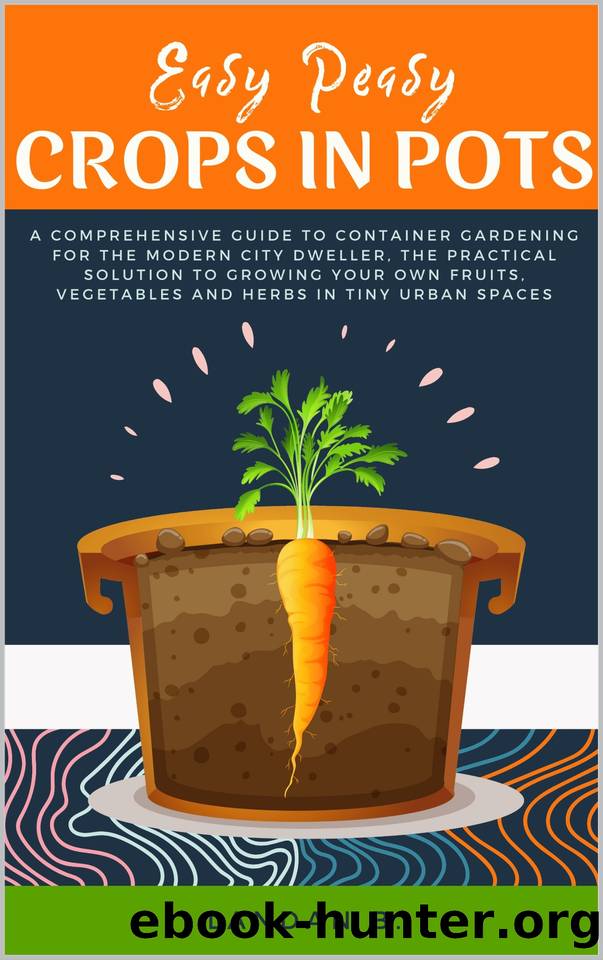Easy Peasy Crops in Pots: A Comprehensive Guide to Container Gardening for the Modern City Dweller, the Practical Solution to Growing Your Own Fruits, Vegetables and Herbs in Tiny Urban Spaces by B. Landan

Author:B., Landan [B., Landan]
Language: eng
Format: epub
Published: 2020-11-04T00:00:00+00:00
Chapter 6: Indoor Edibles
â One of the great benefits of container gardening is that you now can garden indoors! Gardening indoors is fantastic because it brings a fresh green look to your space and can extend your season during cold winters. If you have highly valued perennial plants then you may choose to move them inside during cold months to protect them, promote growth, and improve their overall health. Growing indoors will also allow you to cultivate plants that prefer a dryer climate in wet conditions. In general, indoor gardening allows you to control the environmental conditions of your plants to better suit their needs and if well prepared can allow you to grow almost any crop in any weather!
What to Consider for Your Indoor Garden
Lighting: Light is the power that fuels the growth of your plants. Take time to assess the quantity of light in your indoor space and select the right plant for the environment. Most rooms will be limited by window space and thus only give you partial sunlight, meaning sun-loving plants wonât do great indoors without additional lighting. Consider using shade-tolerant species or boosting your plants with artificial lighting. This can be done with specially designed grow lights, but regular house lights will also provide some additional lighting. Also, be aware that plants grow toward the light! If you're not using additional lighting directly above your plants be aware that they will grow toward your window or an artificial light source. You can counteract this if necessary, by rotating your plants 180 degrees away from the window.
Temperature: Depending on your climate and type of home or indoor structure temperatures will be drastically different. Unventilated structures in hot climates can become exceedingly hot and negatively impact the growth rate and health of your plant. In contrast, indoor gardening is great for cold climates because indoor spaces typically hold more heat than outdoor spaces, especially if your home is well insulated. Even still be aware that some homes and structures may not be insulated enough to prevent freezing indoors and that plants nearest to or touching windows will have a greater risk of being affected. If you wish to increase the temperature of your indoor growing space, you may want to consider supplying some extra light to your plants using incandescent or halogen lights that also produce heat.
Ventilation: If you are growing a large number of plants in a small or completely sealed space consider that you will want to ventilate the air. This will help reduce pests, promote the health of the plants and bring in the carbon-dioxide which is necessary for plant growth. This can be easily done by opening doors and windows or being as complex as building a ventilation system. Unless you are creating a high production and isolated grow room, ventilation systems are not necessary. You may also choose to ventilate to lower the temperature of your grow space.
Cleanliness: One of the first things people might think when growing plants indoors is, how
Download
This site does not store any files on its server. We only index and link to content provided by other sites. Please contact the content providers to delete copyright contents if any and email us, we'll remove relevant links or contents immediately.
On Writing A Memoir of the Craft by Stephen King(4848)
The Doodle Revolution by Sunni Brown(4668)
A Simplified Life by Emily Ley(4081)
Mummy Knew by Lisa James(3621)
Marijuana Grower's Handbook by Ed Rosenthal(3606)
Better Homes and Gardens New Cookbook by Better Homes & Gardens(3509)
Figure Drawing for Artists by Steve Huston(3363)
Paper Parties by Erin Hung(3354)
Draw Your Day by Samantha Dion Baker(3258)
The Genius of Japanese Carpentry by Azby Brown(3209)
Japanese Design by Patricia J. Graham(3098)
The Code Book by Simon Singh(3057)
Dangerous Girls by Haas Abigail(2958)
Lions and Lace by Meagan Mckinney(2911)
The Curated Closet by Anuschka Rees(2897)
How to Make Your Own Soap by Sally Hornsey(2812)
The Checklist Manifesto by Atul Gawande(2763)
The Wardrobe Wakeup by Lois Joy Johnson(2717)
Zero to Make by David Lang(2716)
